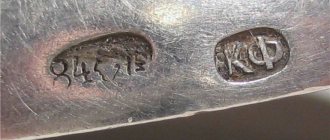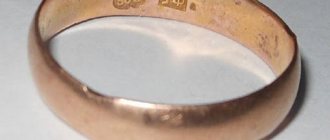Over the past year or two, demand for gold has noticeably revived, not only among central banks and governments that regularly replenish their state reserves, but also among ordinary Russian consumers.
This demand for gold products and even gold bars is generated by the uncertainty of many about the future, the unstable situation in the global economy and politics.
In such a situation, most people try to buy gold in all its types, without particularly understanding the intricacies of where and how this or that jewelry is made, what its real value is, for how much and where it can be sold later, what is the chance that you can buy a regular fake.
Naturally, an ordinary person cannot be an expert who knows all the intricacies of jewelry, much less an art historian who can accurately distinguish the gold jewelry of the Czech masters of the 18th century from what was made by the masters of St. Petersburg in Tsarist Russia, contemporaries of A.S. Pushkin, or at the Demidov factories, from the time of the Russian Empress Catherine.
There are several ways to purchase jewelry and gold products:
- traditional ways of buying gold are jewelry stores, boutiques selling what is produced by modern craftsmen in jewelry factories;
- Another method, which is used by most lovers of beauty, is purchasing through various online auctions and stores, antique shops, pawn shops;
- The third way is to buy jewelry secondhand or as gifts.
When buying gold jewelry, very often people strive to get products made by ancient masters, believing that in this way they are acquiring a true masterpiece.
However, very often when purchasing antique gold jewelry, people are faced with how to assess the real value of their “priceless” acquisition. The fact is that many ancient gold products have different markings from modern ones, i.e., hallmark. On many antique items made of precious metal, you can often notice symbols and numbers that are not entirely clear. As a rule, first of all, we are talking about the sample mark.
So, those products that were manufactured in Russia or imported into Russia before 1927 were marked with 56 gold.
What kind of sample is this
On jewelry made before 1927, 56 was the most common. Usually, thanks to the mark on these jewelry, you can find out who made the product. Jewels with raised markings are of particular importance, since only after 1897 marks began to be made depressed, similar to modern ones. Compared to today's standards, 56 corresponds to 585 gold.
Briefly about the history of appearance
Mandatory marking on products made of precious metals was introduced by Peter I. The spool system was adopted to systematize the quality of gold, control accounting and at the same time bring order to the jewelry industry. Until 1733, products were made without sample. The proposed classification was used until 1927.
History of 56 samples
The old gold alloy, which was marked with the number 56, spread throughout Tsarist Russia. There is significant evidence of this - jewelry items that have come to us from the depths of the 18th and 19th centuries. The stamp, which was placed on almost any piece of jewelry of that period, including coins, indicated not only the number of the gold alloy, but also the surname and initials of the master who made it, the coat of arms of the city, etc. The size of the stamp depended solely on the size of the product. Until the end of the 19th century, this sign had a convex shape. Only in 1897 did the mark take on its usual depressed appearance.
The replacement of the spool system with the metric system, which is still in effect today, took place in 1927. All products that had not found their owners at that time received a new stamp indicating 583, and then 585.
Composition and properties
To make this sample, 56 parts of pure gold and 40 parts of alloys were used. In terms of properties, quality and composition, it corresponds 100% to modern 585 standard. The following metals were often used as alloys:
- silver;
- copper;
- nickel;
- zinc;
- brass;
- palladium.
Such alloys changed the color of the alloy, its ductility and wear resistance. Palladium increased the price of the product several times due to its cost.
Strength
Products made from 56 standard have fairly high strength. The strongest jewelry is considered to be made from an alloy containing nickel, brass or zinc. In addition, this ligature made it possible to create various woven patterns on the decoration.
Alloy shade chart
| Color | Share of gold | Silver | Copper | Nickel |
| Pink (red) | 58.5% | 9% | 32.55% | — |
| Yellow | 58.5% | 18.75% | 22.75% | — |
| Pale yellow | 58.5% | 28% | 13.5 | -? |
| Yellow-green pale | 58.5% | 38.25% | 3.25% | -? |
| White | 58.5% | 25.5% | — | 16.5% |
Expert opinion
Vsevolod Kozlovsky
6 years in jewelry making. Knows everything about samples and can identify a fake in 12 seconds
Palladium changed the properties of products; it did not have a significant effect on color.
Brand
Until 1897, items made from 56 samples were marked with a raised mark. In the 20th century, only depressed ones were done. You can see what it looks like in the photo.
How many carats are in this sample?
The spool system was used in Tsarist Russia, while the metric system was used in the Soviet Union. In the West, the carat system is used to measure fineness.
| Spool value | Metric value | Carat value |
| 56 | 585 | 14 |
Alloy Application
Gold of this type was used to make jewelry and various types of jewelry. Most often, the 56 sample can be found on rings and rings, but it was also used to create earrings, chains, bracelets, crosses, pendants and other products. Today it is used more often than others for making wedding rings.
In the Soviet Union, such a test was used in almost all gold products, marking them with the 585 stamp.
Interestingly, until 1914, this gold alloy was used, among other things, to make Olympic medals and sports cups.
Convert carats to grams
The karat measurement of metals should not be confused with the designation of precious stones.
There the values change, for example, 513 carats corresponds to a stone weighing 102.6 grams, 583 carats - 116.6 grams, 686 carats - 137.2 grams. The metric system determines the value of an alloy based on the gold content of 1 kg of the alloy. The most popular standard is 585, which means that per 1000 grams of alloy there are 585 grams of gold and 415 grams of impurities and other metals.
Since different countries have different systems, sometimes buyers get confused in determining the value of a product when choosing jewelry abroad. Gold hallmarks indicated in carats can be easily translated into understandable Russian numbers: 9 carats means a hallmark of 375 gold, 14 carats means 585, and 24 carats corresponds to the purest gold of 999 purity. For the manufacture of rings, 565 and 575 samples are most often used.
Stamps designate not only products made of gold, but also those made of silver and gilded. For example, a pure silver bar is 999 fine, but this composition is not suitable for making jewelry due to its softness and other physical properties. Household items correspond to hallmark 875, and jewelry - to 925. But gold rings, earrings and chains are not marked with hallmarks 593 and 725. Most likely, you got a fake, and you can determine this fact by contacting a pawnshop or buyers. They will evaluate the product.
Advantages and disadvantages
56 (585) is considered a more valuable alloy than 583, which is most popular in jewelry stores today. But in terms of gold content, 56 is inferior to most samples on the precious metals market. Despite this drawback, it remains popular with us due to certain advantages:
- hardness and wear resistance;
- wide range of colors;
- increased strength and durability;
- plasticity, which allows you to create unique jewelry.
The alloy acquires these properties due to the content of various impurities in it: zinc, copper, palladium, silver, nickel, platinum. The amount of additives does not spoil the overall quality of gold, but only allows you to control its properties.
Advantages and disadvantages
Precious metals, both past and present, have been good investments. Of course, if the jewelry doesn’t look the best or belongs to items that were common at that time (earrings without precious stones, a chain, a cross), then they will buy it back not too expensively, perhaps only for the price of scrap jewelry.
The decoration of such a sample is assessed quite highly, taking into account its historical value , because very often jewelry of those centuries was supplemented with precious stones or they were created by famous master jewelers, for example, Pavel Ovchinnikov or the Grachev brothers. Jewelry made from 56-karat gold was distinguished by its increased strength , which is why many beautiful unique products of high artistic value made from this alloy have been preserved.
The main advantages of 56-carat gold are the following characteristics.
- Wear resistance. Differences in the percentage of impurities affect the amount of wear of products, and since gold itself is a soft metal, this alloy marking is more resistant to mechanical stress.
- Alloy hardness. This characteristic also depends on the quality of the alloy.
- Extended service life.
- Due to the difference in the ratios of additional elements in the alloy, differences appear in the color scheme of the alloy . The most beautiful shades of green, yellow, pink and red can be found in the products of that time.
- Plastic. This parameter allowed jewelers to create truly priceless masterpieces of jewelry, which today are museum exhibits.
The disadvantages include possible allergic reactions due to the high nickel content in the alloy, as well as the difficulty of repair if the jewelry is damaged.
Many workshops refuse to repair 56-karat jewelry due to differences in alloys.
Where can I buy and sell such a sample?
Original 56 mark jewelry can only be purchased from antique dealers. But its metric analogue is available in almost any jewelry store. It was used more often in the Soviet Union, but even today this alloy is found quite often in various products. Jewelry marked 56 hallmark can only be purchased in antique stores, from private individuals or in pawn shops.
Pawnshop and antique dealer
The cost of products with the mark 56 is very high, as they have historical value. The most inexpensive will be wedding rings from pawn shops, inherited ones. But it is difficult to find such specimens.
The minimum price per gram of this alloy in antique shops and pawn shops is 2,000 rubles.
The price increases several times if the product contains precious stones, and the cost will be even higher if there is a jeweler’s mark. Some 56-carat jewelry has a seven-figure price tag.
Gold hallmarking
This operation involves applying a certain mark to jewelry. When buying a trinket you like, first of all, you need to look for the presence of a mark, most often located on the inside of it (ring) or near the clasp. At a close distance from it there is also a marking responsible for the quality of the alloy.
Branding of products began in the 19th century, and continues to do so to this day. The size and shape of the mark depends on the country that makes the jewelry. The Russian sign of authenticity is a female head in a kokoshnik or a five-pointed star. In Ukraine they use a trident, in Belarus - the silhouette of a bison, and in Kazakhstan they put a stamp on jewelry in the form of a snow leopard's head.
Any high-quality gold item has not only a hallmark, but also a state stamp, which is almost impossible to counterfeit.
How much does 1 gram of gold of this standard cost?
The price of gold is determined by the Central Bank of the Russian Federation. But the market value has different meanings for scrap and jewelry. Jewelry often has historical value, so its evaluation should be carried out by a specialist. In this case, the price is influenced by the presence of precious stones, the mark of the jeweler, who used the jewelry and other factors.
| Price 999 standard according to the Central Bank | Market value of the sample today | Scrap price | Price in jewelry |
Red gold - how many impurities are in the alloy?
It is well known that pure gold has a yellow color, but depending on the presence of impurities in the composition, it changes color. The following are used as ligatures:
- copper;
- silver;
- palladium;
- zinc;
- aluminum;
- nickel
- cadmium;
- platinum.
When heated, copper gives this precious yellow metal an aristocratic reddish tint. The more copper in the alloy, the brighter the shade. However, such alloys have a very significant drawback - unlike pure gold, this alloy is already susceptible to corrosion.
Unlike copper, aluminum does not reduce corrosion resistance, but strengthens the alloy. Silver gives the yellow metal a greenish or whitish tint; impurities of platinum and palladium also change the color of gold from yellow to white.
Recommendations for care and cleaning
Products made from precious metals can change color, become dirty and lose their shine. To combat this, you need to clean your jewelry regularly. For this purpose, various means are used. Housewives often use soap solutions, ammonia, and hydrogen peroxide when wiping jewelry. But it is best to purchase a special jewelry paste.
Expert opinion
Vsevolod Kozlovsky
6 years in jewelry making. Knows everything about samples and can identify a fake in 12 seconds
Stores sell entire kits for caring for gold items.
Does gold darken
Darkening on gold products indicates the presence of foreign impurities and low quality of the alloy. 56 standard does not darken, as the quality of this type of gold is high. Slight darkening may occur on items from the 18th–19th centuries.
Why do gold items turn your fingers black?
If the skin of your fingers turns black when wearing a gold ring, this indicates excessive sweating. As a result of the reaction of metal and human sweat, blackening appears. According to experts, it is possible that your menu contains too much meat products. Popular superstitions claim that blackening is a sign of a serious illness or damage to a person.
Appearance of gold streaks
Streaks can appear when a person wearing gold jewelry comes into contact with smoke or soot. Sometimes the cause is excessive sweating. To combat blackening and the appearance of streaks, use high-quality hand cosmetics, wear gloves when working and regularly check your health.
What is it made from, what impurities are added?
Red gold is created by adding no more than 10% copper to pure raw materials. The net weight of each component is called the alloy weight.
Modern products are somewhat different due to the addition of a certain amount of silver, and accordingly, the standard is much lower.
The three-component metal has become widespread due to its high characteristics of malleability, ductility, and strength. The created products turn out to be very wear-resistant, despite the fact that it is almost impossible to visually distinguish them without special knowledge.
Depending on the shade of the product, you can determine which additive was added.
The red material is formed by adding 33.5% copper, 8% silver. When silver is added another 1%, and copper is reduced by 1.5%, a pink color is obtained.
Using 30% silver with 11.5% copper produces a lemon color. When 3% copper, 10% silver, 3.5% zinc and 25% nickel are added to gold, the color produced is white.
The olive tint is formed as a result of the addition of 4% cadmium, 15% silver, 6% copper.
Modern technologies have expanded the overall palette by three more shades. Blue color is obtained by mixing with 54% indium, amethyst - from the introduction of 21% aluminum, and black - 25% cobalt.
Tips for choosing gold jewelry
Purchasing a gold item is a serious procedure. You need to analyze prices and quality in different jewelry stores, checking first of all the following:
- grinding quality;
- uniformity of the surface of the product;
- absence of defects: cracks, depressions, abrasions, dents, breaks, scratches;
- quality of decoration.
In addition, you should pay attention to the tag - a kind of passport of the jewelry. It must be formatted correctly and contain the following information: manufacturer, name;
- company address or contact details;
- the name of the product itself;
- type of metal and its purity;
- weight;
- price.
Expert opinion
Lyudmila Pestereva
Our most experienced gold investor
Ask a Question
Tags that do not have this information are not considered a passport of the product and indicate poor quality of the jewelry, possible counterfeiting and cheapness.
Red gold is not 999 fine
Gold mined in mines is not a perfectly pure metal and already contains a number of impurities. However, after purification, the metal turns into precious 999 fine bars and is sent to banks for storage. A pure gold bar can be damaged, scratched and bent without much effort. At the same time, many mistakenly call 999 fineness the devil's gold, meaning by this term a perfectly refined precious metal.
Red gold is an alloy of gold and copper, due to the ligature, a reddish noble shade of the precious metal is obtained.
Reviews
Maria:
“My grandmother gave me a ring, no stone, just a nice ring with a small pattern. On the inside there is an o, which, as I later learned, means a test. At first I doubted that we have a three-digit standard system for gold. I googled it and it turned out to be simple: the ring was made back in the days of the spool system. What can I say - the ring is beautiful, it has not changed color, does not darken and does not stain the skin. Grandma clearly looked after him, I continue this tradition.”
Konstantin:
“A chain with 56 hallmarks, the lock broke, I turned to the jeweler for help. He suggested installing a new one, made from a modern alloy. There was no choice - I had to replace it. And a year later I got caught on the railing and pulled the chain hard, so the new lock broke, but my father’s 56-grade chain was not damaged anywhere.”
Arina:
“Good gold was made in Tsarist Russia, my father has a ring that has been inherited for several generations, the 56th standard is marked with a hallmark. It does not turn black, does not stain the skin, and does not need to be cleaned often - it’s a pity that there are no such good alloys today.”
Sample systems: metric, carat, spool
The numerical designation of the sample is applied to all jewelry, but not all jewelry is marked according to a single system. Today, two sample systems are used - metric and carat, but in the last century in Russia the spool system was used.
Metric
Used in most countries of the world. The highest standard of the system is 1000th. For example, a 750 gold alloy contains 75% gold, the remaining 25% comes from other metals.
It is difficult to achieve the exact content of precious metal in an alloy, so GOST sets a remedium of 3 units for alloys containing gold, silver, and copper. That is, a gold alloy of 375 purity of gold should contain from 372 to 378 units (a deviation of 3 units in both directions is allowed). If the material contains nickel, then the remedium is 5 units. For an alloy of 585 standard, only a positive remedium of 5 units applies - deviations are allowed upward, but not downward.
Carat
Currently used in some European countries and the USA. The highest standard of the system is 24. Samples of 9, 14, 18, 22 are used - they show the content of pure precious metal in the composition. For example, 18 karat gold means that 18 of 24 parts are pure gold (this corresponds to 750 fine gold in the metric system). 1 carat in this system is equal to 9.744 grams.
Zolotnikovaya
Spool samples are old gold samples; they are no longer used. This system was used in Russia until 1927. The highest standard is 96. The units of measurement are:
- 1 pood = 40 pounds = 16.380 kilograms.
- 1 pound = 96 spools = 409.512 grams.
- 1 spool = 4.266 grams = 96 shares.
- 1 share = 0.044 grams.
For marking jewelry, samples of 56, 72, 92, 94 were used. If a sample of 56 was indicated, this meant that 1 pound (96 spools) of such an alloy contained 56 spools of pure gold (this corresponds to 585 samples of the metric system).
Table of the relationship between the spool system and the modern metric system
| Zolotnikovaya | Metric |
| 36 | 375 |
| 48 | 500 |
| 56 | 585 |
| 72 | 750 |
| 92 | 958 |
| 96 | 999 |
The spool testing system was used in Russia from the founding of the Assay Supervision Inspectorate in 1798 until 1927.
It is very difficult to determine more precisely the age of the jewelry that bears the 56th standard. If, in addition to the hallmark, there is a manufacturer's name on the jewelry, then you can look for a specialist among antique dealers who will try to determine the year of manufacture of your jewelry. You can read more about this in the article How to determine the age of jewelry.
Sources
- https://goldsovet.ru/skupka-zolota-56-proby
- https://ToZoloto.ru/proba/56-proba-zolota.html
- https://VseoMetallah.ru/zoloto/proba/proba-56-na-zolote
- https://bank25.ru/zoloto-56/
- https://zhazhdazolota.ru/proby/56
- https://zolotogid.ru/metally/sistema-oboznacheniya-proby-na-zolotyh-izdeliyah-i-pozolote/
- https://vplate.ru/zoloto/chto-oznachaet-56-proba/
- https://grandfor.ru/uslugi/zoloto-56-proby/
- https://russam.ru/stati/o_juvelirnyh_izdelijah/p18881-kakie_byvajut_proby_zolota/
- https://prozoloto.com/uvelir/skolko-stoit-56-proba-zolota/
Red gold coins
And now a few more words about the minting of red gold coins. The historical period in which certain “chervonets” were made is important. For example, during the reign of Tsar Nicholas II, the mint minted gold coins of only 900 fineness, which corresponds to 86.4 spools.
In more ancient times, when Russia was ruled by Peter I, mints produced coins from pure 94-carat gold, which was only slightly inferior to the modern 999-carat gold. However, it is known that, along with 94-carat gold, lower carats were also used to produce coins. As such, these coins had less value and were intended for use within the state.











